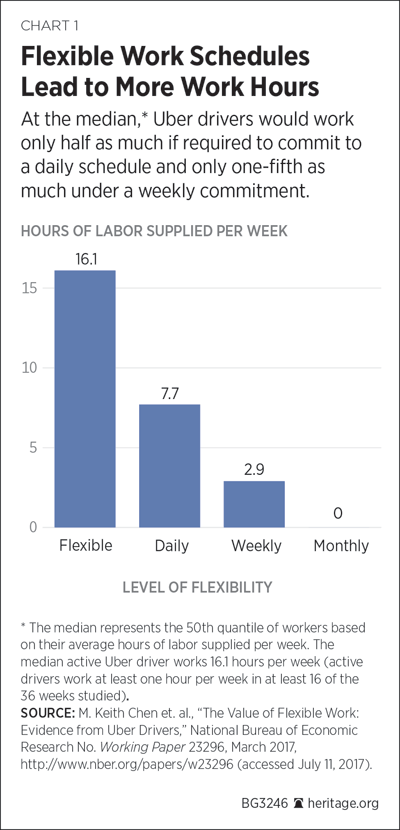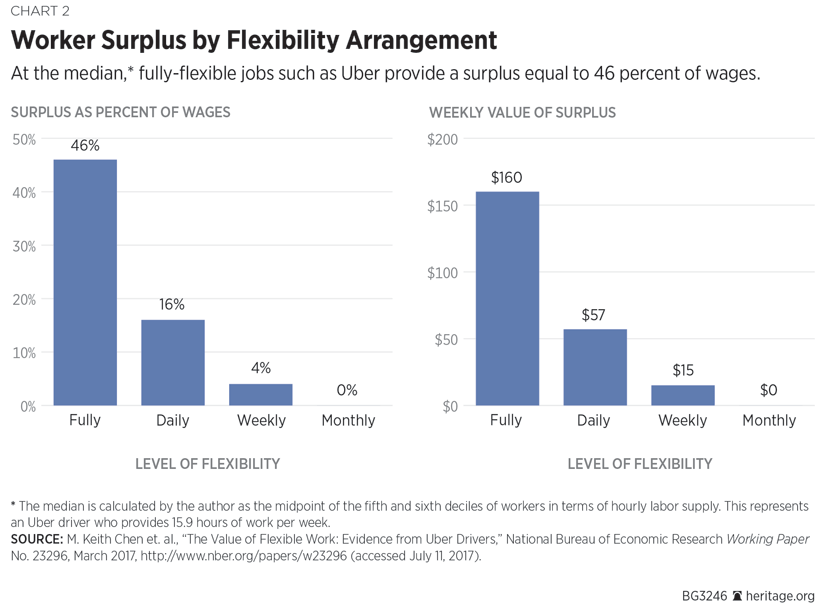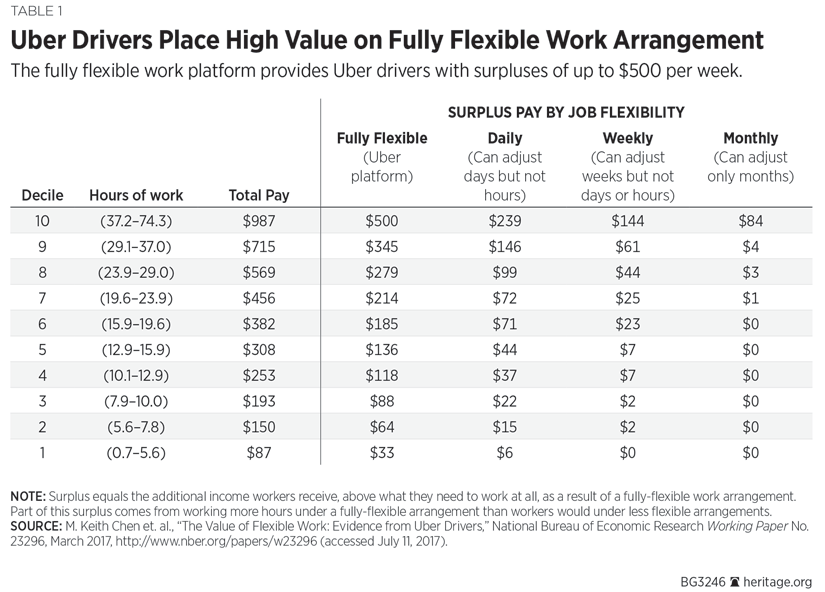Job flexibility has long been considered one of the “immeasurable” components of compensation. No one denies that flexibility has value to workers, but that value is hard to quantify. However, the Uber ride-sharing platform provides economists with a unique way to estimate the value of various levels of job flexibility and adaptability. Based on data from close to 200,000 active Uber drivers, economists have estimated the value of a fully flexible job—similar to what Uber provides—at 40 percent of expected earnings or $150 per week for the average Uber driver.
Growth in Flexible Independent and Gig-Economy Jobs
Over the past decade, the percentage of American workers with flexible contract work—including gig-economy jobs—as their primary employment is estimated to have increased 56 percent, from 10.1 percent of all workers in 2005 to 15.8 percent in 2015.[REF] Another estimate of “independent workers” that includes workers with non-primary flexible or alternative jobs calculates the so-called independent U.S. workforce at 30 million.[REF]
While alternative, flexible work arrangements are on the rise in the U.S., low-wage workers have more limited access to flexible jobs.[REF] Uber and other gig-economy businesses such as Task Rabbit and Door Dash provide new opportunities for semi-skilled and lower-wage workers to access fully flexible jobs. Unlike traditional 9:00-to-5:00 jobs, Uber and other gig-economy jobs provide a unique platform that allows workers to act as their own bosses, entering and exiting work whenever they choose—the definition of a “fully flexible” or “gig-economy” job.
Surveys show that 91 percent of Uber drivers chose to partner with Uber for work because it allows them to earn more income to support themselves and their families; 87 percent chose it because it allows them to be their own bosses and set their own schedules; 85 percent chose it for the flexibility and better work–family balance; and 75 percent cited Uber as a means to maintain a steadier income than they receive from other unstable income sources.[REF]
Using Uber Data to Model the Value of Job Flexibility
A dataset from Uber that contains data on over 1 million registered UberX drivers (UberX is Uber’s primary, peer-to-peer service) who provided 184 million hours of work over an eight-month period from September 2015 to April 2016 provides a unique opportunity for economists to estimate the value of job flexibility.[REF] It should be noted, however, that this dataset and study is limited to workers who are active Uber drivers and who do not necessarily resemble all workers.[REF] Many Uber drivers use Uber as an additional source of income while in school or working another job, and they have a higher preference for flexibility than the average worker has.
After analyzing data from roughly 200,000 active Uber drivers over 102 million hours of work, economists built a model to estimate workers’ willingness to provide labor based on varying levels of job flexibility. To determine the value of job flexibility, the authors of the study compared the Uber platform to alternative levels of flexibility: daily flexible jobs that allow workers to choose what days they work, weekly flexible jobs, monthly flexible jobs, and “taxicab” model jobs in which workers choose what day and shift to work but must commit to that entire day/shift.
Greater Flexibility Increases Hours of Work
The Uber study revealed that the more flexible the job, the more labor workers provided. At the median, the authors of the study estimated that workers would provide 16.1 hours of fully flexible work per week, 7.7 hours of daily flexible work, and 2.9 hours of weekly flexible work. If these workers had to commit to working a full month, the median Uber driver would not work at all.

These findings show that the types of workers who drive for Uber—and there are over 1 million registered Uber drivers in the U.S.—place a significant value not just on being able to pick their own schedules, but specifically on the ability to adapt their schedules based on unpredictable events and preferences. Freed from the “taxicab” restraint that effectively requires workers to commit to an entire shift, the average worker will triple his or her labor supply from five to 15 hours per week.[REF]
It may seem unreasonable that workers would shift their labor supply so dramatically or even drop out of the labor force entirely if they have to commit to working a full month, but the authors noted, “What we have learned is that ability to adapt [to] unpredictable shocks attracts Uber drivers, and without this adaptability, they will not participate much in the labor market.”[REF]
The Value of Flexibility
As a result of working more hours because of more flexible jobs, workers achieve significant wage surpluses that can be interpreted as the value of flexibility. In percentage terms, worker surpluses for fully flexible jobs varied from 38 percent to 51 percent of wages, with the highest surpluses going to those who supplied the most hours of work.[REF] In dollar terms, surpluses ranged from $33 per week for workers who supplied fewer than six hours of work to $500 per week for those who worked 37 hours or more.

In order to supply any labor, workers must receive a positive surplus, but the level of surplus declines as flexibility declines. The Uber study found that daily flexibility provided only about one-third as much surplus as full flexibility, while weekly flexibility provided only one-tenth as much surplus.
Potential Impacts of Flexible Work on Labor Supply
The nature of highly flexible and gig-economy jobs could significantly alter the U.S. labor market equilibrium. As demonstrated by the Uber study, greater flexibility causes workers to increase their total labor supply. Moreover, the ability to adapt labor supply on an hourly basis could lead to higher labor-supply elasticities, which means that workers would be more responsive to both marginal tax and wage rates.
Workplace flexibility could also affect individuals’ and families’ interactions with government welfare programs. For example, a recent story in the Jamestown, New York, Post Journal noted that Uber’s arrival in the area had provided an opportunity for work and income for an individual who was previously unable to obtain employment.[REF] This shows how fully flexible jobs can help some individuals to move out of government welfare programs and into self-sufficiency.

Efforts to Squash Fully Flexible, Gig-Economy Platforms
While some politicians welcome gig-economy platforms like Uber as a means to increase jobs and incomes, others—in large part as a result of opposition from competing special interests that stand to lose business to the new platforms—seek to outlaw or excessively regulate such businesses.
For example, opposition has sought to reclassify some gig-economy workers such as Uber drivers as employees rather than independent contractors.[REF] This would overturn the entire gig-economy business model and end most gig-economy jobs. Instead of gig-economy workers operating as their own bosses, companies would be forced to take control of workers’ schedules and activities, but such control would eliminate the flexibility that attracts workers to such jobs in the first place. Congress should clarify “independent contractor” status under federal law to specify that individuals who control their work, use their own equipment, and make independent business judgements are independent contractors and not employees.[REF]
Some local lawmakers have placed outright bans on Uber and other ride-sharing services (as in most locations in Oregon, outside of Portland)[REF] or have enacted oppressive regulations that force those companies to withdraw from the market.[REF] Even where Uber still operates, government-imposed constraints and cronyism often unnecessarily stifle innovation and drive up costs for Uber drivers and riders alike. In Massachusetts, for example, Uber is forced to subsidize taxicab competitors through a tax that transfers five cents from every ride—or roughly $1.5 million per year—to the state’s taxi companies.[REF] Lawmakers should avoid unnecessarily regulating gig-economy businesses that offer innovative, desirable, and flexible jobs for workers that raise incomes while providing highly desirable products to residents.
Conclusion
Highly flexible and gig-economy jobs have increased in the U.S. by at least 55 percent over the past decade. Although previously regarded as “immeasurable,” a study of Uber driver data shows that a fully flexible job platform significantly increases workers’ labor supply and results in a surplus, or flexibility value, equal to between 38 percent and 50 percent of total driver earnings.[REF] Continued growth in more flexible, alternative work arrangements could provide valuable job and income growth opportunities, particularly for lower-wage workers.
Federal lawmakers should clarify the status of gig-economy workers as independent contractors so that they can maintain the flexibility in their work that they desire. Moreover, local policymakers should not block the growth of more flexible jobs by outlawing them or using oppressive regulations to force them from certain localities. Fully flexible and gig-economy jobs provide the flexibility, control, and additional income opportunities that many workers desire, and policymakers should not use crony or protectionist legislation to squash these opportunities.
—Rachel Greszler is Research Fellow in Economics, Budget, and Entitlements in the Thomas A. Roe Institute for Economic Policy Studies, of the Institute for Economic Freedom, at The Heritage Foundation.



